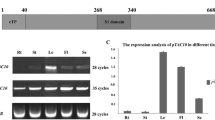Abstract
A general characteristic of the 3′-untranslated regions (3′ UTRs) of plastid mRNAs is an inverted repeat (IR) sequence that can fold into a stem-loop structure. These stem-loops are RNA 3′-end processing signals and determinants of mRNA stability, not transcription terminators. Incubation of synthetic RNAs corresponding to the 3′ UTRs of Chlamydomonas chloroplast genes atpB and petD with a chloroplast protein extract resulted in the accumulation of stable processing products. Synthetic RNAs of the petA 3′ UTR and the antisense strand of atpB 3′ UTR were degraded in the extract. To examine 3′ UTR function in vivo, the atpB 3′ UTR was replaced with the 3′ UTR sequences of the Chlamydomonas chloroplast genes petD, petD plus trnR, rbcL, petA and E. coli thrA by biolistic transformation of Chlamydomonas chloroplasts. Each 3′ UTR was inserted in both the sense and antisense orientations. The accumulation of both total atpB mRNA and ATPase β-subunit protein in all transformants was increased compared to a strain in which the atpB 3′ UTR had been deleted. However, the level of discrete atpB transcripts in transformants containing the antisense 3′ UTR sequences was reduced to approximately one-half that of transformants containing the 3′ UTRs in the sense orientation. These results imply that both the nucleotide sequences and the stem-loop structures of the 3′ UTRs are important for transcript 3′-end processing, and for accumulation of the mature mRNAs.
Similar content being viewed by others
References
Barkan A: Proteins encoded by a complex chloroplast transcription unit are each translated from both monocistronic and polycistronic mRNAs. EMBO J 7: 2637–2644 (1988).
Blowers AD, Klein U, Ellmore GS, Bogorad L: Functional in vivo analyses of the 3′ flanking sequences of the Chlamydomonas chloroplast rbcL and psaB genes. Mol Gen Genet 238: 339–349 (1993).
Chen Q, Adams CC, Usack L, Yang J, Monde R-A, Stern DB: An AU-rich element in the 3′untranslated region of the spinach chloroplast petD gene participates in sequence-specific RNA-protein complex formation. Mol Cell Biol 15: 2010–2018 (1995).
Drager RG, Zeidler M, Simpson CL, Stern DB: A chloroplast transcript lacking the 3′ inverted repeat is degraded by 3′ → 5′ xoribonuclease activity. RNA 2: 652–663 (1996).
Feinberg AP, Vogelstein B: Atechnique for radiolabeling DNA restriction endonuclease fragments to high specific activity. Anal Biochem 132: 6–13 (1983).
Hayes R, Kudla J, Schuster G, Gabay L, Maliga P, Gruissem W: Chloroplast mRNA 3′-end processing by a high molecular weight protein complex is regulated by nuclear encoded RNA binding proteins. EMBO J 15: 1132–1141 (1986).
Lee H, Bingham SE, Webber AN: Function of 3′ non-coding sequences and stop codon usage in expression of the chloroplast psaB gene in Chlamydomonas reinhardtii. Plant Mol Biol 31: 337–354 (1996).
Lisitsky I, Klaff P, Schuster G: Addition of destabilizing poly(A)-rich sequences to endonuclease cleavage sites during the degradation of chloroplast mRNA. Proc Natl Acad Sci USA 93: 13398–13403 (1996).
Lisitsky I, Liveanu V, Schuster G: RNA-binding characteristics of a ribonucleoprotein from spinach chloroplasts. Plant Physiol 107: 933–941 (1995).
Marzluff WF: Histone 3′ ends: essential and regulatory functions. Gene Expr 2: 93–97 (1992).
Merchant S, Selman BR: Synthesis and turnover of the chloroplast coupling factor in Chlamydomonas reinhardtii. Plant Physiol 75: 781–787 (1984).
Nierlich DP, Murakawa GJ: The decay of bacterial messenger RNA. In: Cohn WE, Moldave K (eds) Progress in Nucleic Acid Research andMolecular Biology, pp. 153–216. Academic Press, San Diego, CA (1996).
Rott R, Drager RG, Stern DB, Schuster G: The 3′ untranslated regions of chloroplast genes in Chlamydomonas reinhardtii do not serve as efficient transcriptional terminators. Mol Gen Genet 252: 676–683 (1996).
Rott R, Nelson N: Purification and immunological properties of proton-ATPase complexes from yeast and rat liver mitochondria. J Biol Chem 256: 9224–9228 (1981).
Schuster G, Gruissem W: ChloroplastmRNA3′ end processing requires a nuclear-encoded RNA binding protein. EMBO J 10: 1493–1502 (1991).
Schuster G, Timberg R, Ohad I: Turnover of thylakoid photosystem II proteins during photo inhibition of Chlamydomonas reinhardtii. Eur J Biochem 177: 403–410 (1988).
Shepherd HS, Boynton JE, Gilham NW: Mutations in nine chloroplast loci of Chlamydomonas affecting photosynthetic functions. Proc Natl Acad Sci USA 76: 1353–1357 (1979).
Standart N, Jackson RJ: Regulation of translation by specific protein/mRNA interactions. Biochimie 76: 867–879 (1994).
Stern DB, Gruissem W: Control of plastid gene expression: 3′inverted repeats act as mRNA processing and stabilizing elements, but do not terminate transcription. Cell 51: 1145–1157 (1987).
Stern DB, Gruissem W: Chloroplast messenger RNA 3′ end maturation is biochemically distinct from prokaryotic messenger RNA processing. Plant Mol Biol 13: 615–625 (1989).
Stern DB, Jones H, Gruissem W: Function of plastid mRNA 3′ inverted repeats. RNA stabilization and gene-specific protein binding. J Biol Chem 264: 18742–50 (1989).
Stern DB, Kindle KL: 3′end maturation of the Chlamydomonas reinhardtii chloroplast atpB mRNA is a two-step process. Mol Cell Biol 13: 2277–2285 (1993).
Stern DB, Radwanski ER, Kindle KL: A 3′stem/loop structure of the Chlamydomonas chloroplast atpB gene regulates mRNA accumulation in vivo. Plant Cell 3: 285–297 (1991).
Wahle E, Keller W: The biochemistry of 3′-end cleavage and polyadenylation ofmessenger RNAprecursors. Annu Rev Biochem 61: 419–440 (1992).
Woessner JP, Gillham NW, Boynton JE: The sequence of the chloroplast atpB gene and its flanking regions in Chlamydomonas reinhardtii. Gene 44: 17–28 (1986).
Yang J, Schuster G, Stern DB: CSP41, a sequence-specific chloroplast mRNA binding protein, is an endoribonuclease. Plant Cell 8: 1409–1420 (1996).
Author information
Authors and Affiliations
Rights and permissions
About this article
Cite this article
Rott, R., Liveanu, V., Drager, R.G. et al. The sequence and structure of the 3′-untranslated regions of chloroplast transcripts are important determinants of mRNA accumulation and stability. Plant Mol Biol 36, 307–314 (1998). https://doi.org/10.1023/A:1005943701253
Issue Date:
DOI: https://doi.org/10.1023/A:1005943701253




